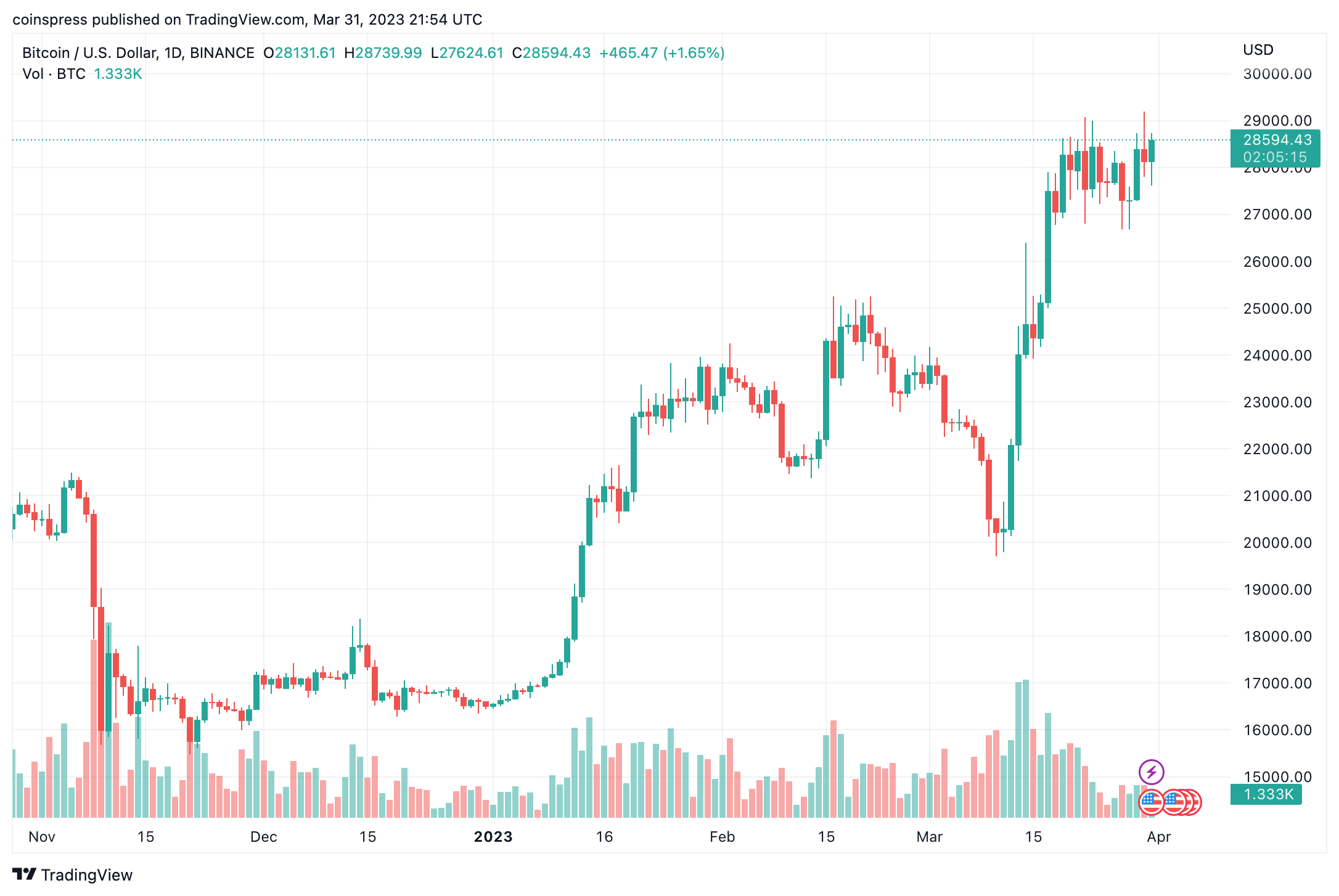Bitcoin’s Ups and Downs: A Look at Price Movements and Market Trends

During this year's banking crisis, Bitcoin's price surged above $25,000, a threshold it hadn't seen since June 2022.
Some supporters of Bitcoin claimed that the bank’s failure was causing investors to turn to digital currencies and even went so far as to suggest that this marked the end of the USD.
The rising price of Bitcoin is not necessarily attributed to the collapse of big names in the banking industry. There are a lot of factors that could contribute to the price surge and increased interest.
All in all, people aren’t so positive about the future of the US dollar – and for a good reason.
Analysts have pointed out that the recent increase in Bitcoin’s price is likely due to various financial trends rather than any philosophical shift towards digital currencies.
The possibility of the FED pausing interest rate increases is one of the factors that could have had a considerable impact. Additionally, low liquidity in the market has made it harder to buy and sell Bitcoin without affecting its price, leading to increased volatility.
Recent price movement
Bitcoin peaked at $29,380 on March 24 before experiencing a resurgence of sell pressure. Now, one week later, the bulls are yet again showing their strength.
Analysts and enthusiasts anticipate BTC breaking past the $30,000 barrier in the near future.
At the time of writing, the flagship cryptocurrency is trading at $28,600 after a 1.55% increase on the daily chart with a 24-hour trading volume of over $19 billion.

Upon examining Bitcoin’s current position, it appears that sell pressure has affected its performance. Bitcoin’s upward momentum recently reached the ascending resistance line and pushed back.
Bitcoin ethos
Bitcoin emerged in the aftermath of the 2008 financial crisis, which created widespread distrust in the banking system. Early adopters touted it as a more secure and reliable alternative to traditional currencies and financial institutions.
READ MORE: Bitcoin’s Rally Could be Short-Lived: Expert Predicts Significant Drop in Value
However, this initial vision has not materialized. Instead, over the past decade and a half, Bitcoin has primarily been used as a speculative investment vehicle and, in some cases, to facilitate illicit activities such as money laundering.
Nonetheless, the recent collapse of Silicon Valley Bank and the broader crisis it triggered have lent support to Bitcoin’s original thesis.
A closer look at Bitcoin’s fundamentals
According to Glassnode, there has been an increase in the amount of Bitcoin being held long-term, but there has also been a recent rise in sell pressure. On-chain exchange outflow hit $1.1 billion daily, while inflows were lower at $921 million.
The market may experience a decline if there are enough sellers, but if the buyers dominate, Bitcoin’s value could rise above $30,000, breaking through the resistance level.

Based on exchange data within the last 24 hours, there has been a significant decrease in both inflows and outflows. However, exchange outflows slightly exceeded exchange inflows at 22,178 BTC compared to 20,548 BTC at the time of writing.
Investors should note that Bitcoin’s open interest in the derivatives market is currently at its highest point in two months, suggesting strong demand for BTC. Additionally, the estimated leverage ratio indicates the increase in demand for leverage.
The levels of Social Volume and Social Dominance have reached a peak not seen in a year, suggesting that there is growing enthusiasm among the masses. Typically, this signals a potential local top on the horizon.

The metric “BTC’s Dormant Circulation (5y)” measures the amount of coins that have been inactive for the past 5 years and have recently become active again.
Starting from mid-March, there have been two significant surges between 2800 – 3000 BTC, which are long-term (5 years).

Whether this results from the recent crypto crackdown or the CTFC vs. Binance case remains uncertain.
Nonetheless, a large cryptocurrency holder may be experiencing some uneasiness regarding the current situation.
The amount of addresses with 10 or more BTC has recently hit a three-year peak of 156,129, surpassing the previous high of 156,118, which was recorded on March 15, 2023.

The seven-day moving average of BTC transaction volume has risen to a four-month high of 44,974.327 BTC, surpassing the previous high of 44,867.517 BTC, which was noted on March 24, 2023.

Santiment reports that the largest whale transactions for Bitcoin occurred during the month of March. One notable transaction involved 40,141 BTC and was executed on March 15.
Popular Bitcoin predictions
According to Cathie Wood, CEO of ARK Invest, Bitcoin has the potential for significant growth in the event of a loss of confidence in the current financial system.
She points out that the supply of Bitcoin is limited to 21 million units, with an inflation rate of 1.8% per year based on the current mining rate. As the total supply of BTC is exhausted, the inflation rate will be cut in half to less than 1%.
With only 19 million units available, Bitcoin’s recent rally during a banking crisis and economic uncertainty indicates its success as a store of value.
Wood believes that this success is the reason behind the recent increase in Bitcoin’s price from $19,000 to nearly $29,000. She predicts BTC will reach $1 million per coin in the long term.
According to the Observer, Tim Draper, a billionaire venture capitalist with a track record of successful investments in companies such as Coinbase, Hotmail, Skype, Tesla, and Twitter, has shared his bullish outlook on Bitcoin’s price.
Draper predicts that the top cryptocurrency will surge to an astounding $250,000 in the near future, citing a parabolic rally that has only just commenced.
He further elaborated that this rally will result in gains exceeding 900% in less than two years.
According to Draper’s recommendations, companies should maintain a reserve of short-term cash in two separate banks, one local and one global, amounting to a minimum of six months’ worth.
READ MORE: EU Lawmakers Set Limits on Unverified Crypto Users
Additionally, keeping a portion of their funds in Bitcoin or other cryptocurrencies equivalent to at least two payrolls is suggested.
Draper believes that investing in Bitcoin serves as a protective measure against the risk of a “domino effect” in the banking sector, as well as against the negative impact of excessive government regulation.
Steve Wozniak, the renowned co-founder of Apple, has shared his insights on the potential future value of Bitcoin. Given the rising popularity of cryptocurrencies and his intuition, Wozniak predicts that Bitcoin’s price could reach an impressive US$100,000.
In his view, Bitcoin stands out from other currencies because it was created with a strong mathematical foundation. Unlike traditional currencies, Bitcoin is not controlled by any individual, company, or known creator. Instead, its operation is purely based on mathematical principles.
Bitcoin’s current state
Bitcoin’s price has surged by around 40% since Silicon Valley Bank’s fall in March, increasing from $20,000 to $28,000. However, this is still considerably lower than its peak of almost $70,000 in November 2021.
The rise was partly due to issues in other areas of the cryptocurrency industry. Circle, one of the largest stablecoin issuers, had billions of dollars at risk during the banking crisis, causing panic among investors.
Crypto traders who held their digital savings in stablecoins are now looking for other options. The bank runs also created excitement among crypto investors, as some hoped that the Federal Reserve would slow down its interest-rate increases to calm the panic.
According to a well-known crypto critic, Bitcoin’s price began increasing when the government announced it would support Silicon Valley Bank. The Federal Reserve’s announcement of another rate increase had little impact on Bitcoin’s price, which has settled at around $28,000.
However, this has not deterred Bitcoin enthusiasts from seeking new adherents.
Some people believe that Bitcoin will become the global reserve currency, and this is the best moment for Bitcoin marketing and adoption in its history.
Bitcoin’s price throughout the years
Bitcoin has come a long way, and since its genesis, it has brought more profits to its holders than one could have imagined 15 years ago. Early adopters are the ones who benefited the most, but if you look at historical data – it may not be too late to get on the bandwagon.
Take a look at Bitcoin’s price history:
- 9 years ago – $457
- 8 years ago – $244
- 7 years ago – $417
- 6 years ago – $1,072
- 5 years ago – $6,974
- 4 years ago – $4,105
- 3 years ago – $6,439
- 2 years ago -$58,919
- 1 year ago – $45,539
- Today – $28,600
Evidently, Bitcoin is proving its worth as an investment vehicle, not only as a means to earn profits but also as a safe haven asset.
Conclusion
The adoption of Bitcoin can be seen throughout the globe. People are beginning to acknowledge BTC’s value – giants like Fidelity, BlackRock, BNY Mellon all want a piece of the pie.
READ MORE: The RESTRICT Act: A Threat to Crypto and Other Technologies
Most likely, we are still in the early stages of this digital revolution and have much more to see. Although there are currently more than 20,000 cryptocurrencies, many of them have absolutely no instinct value. One thing is for certain, though – Bitcoin has proven its sustainability, especially in today’s financial climate.
Whether you are a crypto critic or enthusiast, you can’t discredit what Bitcoin has achieved throughout the years.
With the upcoming halving in 2024, you can’t help but feel more optimistic about the near-future prospects of the number one cryptocurrency. Experts expect a major price surge even before the event occurs.
Last time we witnessed the uptrend’s beginning of the uptrend 1 year before the halving and the real bull-run 1-year after the event.
This is probably the hardest time for Bitcoin since a financial crisis of immense magnitude is upon us. The digital currency has to prove whether or not it is one of the better options to hedge against inflation – as it is intended in its whitepaper.













